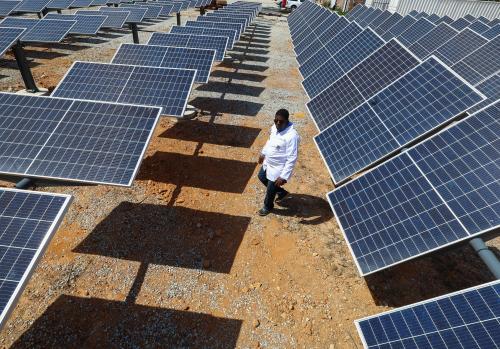Different pollution control policies, even if they achieve the same emissions goal, could have importantly different effects on the composition of the energy sector and economic outcomes. In this paper, we use the G-Cubed1 model of the global economy to compare two basic policy approaches for controlling carbon emissions from power plants: (1) a tradable performance standard and (2) a carbon tax.
We choose these two approaches because they resemble two key options facing policymakers: continue implementing a performance standard approach under the Clean Air Act or adopt an excise tax on the carbon content of fossil fuels instead. Our goal is to highlight the important high-level differences in these basic approaches, abstracting from the details of specific policy proposals. We explore a wide variety of the illustrative policies’ economic outcomes including: changes in capital stocks and electricity production across eight types of generators, changes in end-user electricity prices, changes in gross domestic product (GDP), overall welfare impacts on the household sector and, finally, one outcome represented in the G-Cubed model and few others: short to medium-run changes in aggregate employment.
We find that a national tradable performance standard (TPS) of the ambition reflected in EPA’s draft Clean Power Plan (CPP) could achieve a significant reduction in future economy-wide emissions relative to business as usual, and would stabilize emissions from electricity generation through 2030 with only a very small reduction in GDP. A carbon tax on fuel purchased by the electric sector would have a similarly small effect on GDP but would be slightly more efficient.
While both policies would have similar and relatively modest effects on the economy as a whole, they have markedly different effects on the electricity generation sector. For an equivalent effect on electric sector emissions, a TPS produces a significantly larger shift to non-fossil generation as a result of the large credit payments it induces between the fossil and non-fossil generating sectors. However, a carbon tax, which shifts some revenue to households through the tax system, produces a slightly better economy-wide outcome as measured by equivalent variation. Both policies cause a variety of reallocations of investment and employment between the clean energy sectors and the rest of the economy.
Finally, it is important to note that many of our key results are robust to wide variations in the assumed elasticity of substitution between different generation technologies. Effects on electricity prices, overall GDP, employment and welfare are modest and change little in response to changes in the elasticity. However, some results are more sensitive: as it becomes easier to substitute between energy generation technologies (particularly between fossil and non-fossil technologies), the price of a TPS credit falls, as does the size of the carbon tax, and the many of the outcomes under the two policies tend to converge. On the other hand, as it becomes more difficult to substitute generation technologies, the differences between the TPS and the carbon tax become larger, as does the efficiency advantage of the carbon tax.
1. See McKibbin and Wilcoxen (2013). The version in this paper is 124e.












